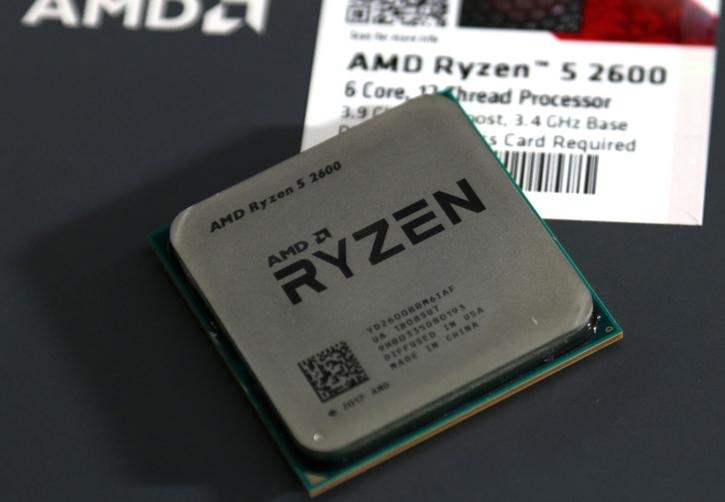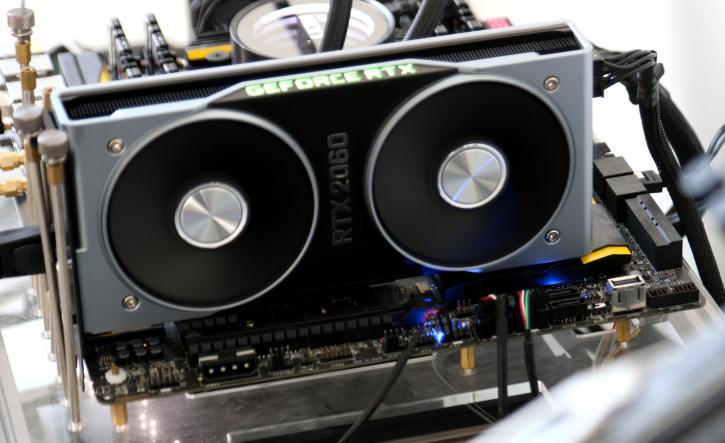The Mainstream / Mid-Range Build
The Mainstream/Mid-Range Build
For building a gaming PC, we suspect that this is the bracket toward which most people will be venturing first. The build structure doesn't change at all from the entry-level, and just some small added expenses onto each part can make for a significantly enhanced gaming experience.
In my original draft of this guide, the 'higher end' GPU options solely revolved around the 1070/1070Ti. However, since then, both of these cards are now subject to overly inflated prices. Thanks to this, Nvidia's new RTX 2060 will certainly be making an appearance.
CPU - AMD Ryzen 5 2600
This should come as no surprise. If you are playing at appropriate settings for your GPU (i.e. not 1080p on an RTX 2080 Ti), then your GPU will be your system's bottleneck in 99% of cases, even when taking into account the slightly lower IPC and notably reduced clock rates on AMD's Ryzen+ CPUs. Naturally, you should overclock these chips to get the best out of them, and hope to match the performance offered by the 2600X. However, with the 2600X, there is certainly a case for purchasing one and allowing AMD's excellent XFR2 and Precision Boost Overdrive to dynamically overclock the CPU in all scenarios. However, I like saving money, and like overclocking.
There are several reasons for me recommending Ryzen, even with the prospect of Zen 2 so close on the horizon... pun partially intended. For one, the 2600 makes an excellent 'all-round' CPU. Gaming, content creation, multi-tasking, streaming, productivity, etc. It offers 12 threads, which is becoming ever more important in a world where cores/threads of your CPU are really starting to matter.
Motherboard - MSI B450 Tomahawk
We can afford to spend a little more, here, and MSI's range of AM4 motherboards for 2nd Generation Ryzen really hit it out of the park. Our pick is their B450 Tomahawk. We actually reviewed this board, the link to which I will leave here. It features 4 DIMM slots, a very solid I/O, nice build quality, and - perhaps my favourite bit... surprise surprise - a very solid 4+2 phase VRM that is entirely adequate for an octa-core like the R7 2700, even when overclocked. Therefore, a 2600 with merely 6 ('merely') cores will be of no sweat to it.
Naturally, there ARE more boards out there, and you might find that that the above is too expensive in your country, or simply not available. Do not fear, however. It really is as simple as picking a B450 board that isn't outrageously priced. The above, aside from being a solid choice all around, represents a perfectly reasonable option for this level of build.
CPU Cooler - 120/140mm air cooler
Apologies for the vagueness, here, but you have the budget to be a little free(er) with what you want to go for. Our money is still on a cooler in the 30-40 USD range, such as the Arctic Freezer 33, BeQuiet Pure Rock, or Cooler Master MA410P (which many consider to be the 212 Evo's spiritual successor). Either way, most picks in this category will suffice perfectly for an overclocked 6 core, as long as you are not pushing 1.4V and beyond through the chip. If you are, why?
There is no point of pairing an AIO with a 2600. They might peform better than a small 120mm air cooler, but they're disproportionately more expensive, and so are left off (for now). Again, we are only including a CPU cooler on the assumption that you will be overclocking your CPU. If you choose not to, then feel free to save a penny and just use the boxed cooler.
RAM - Team Group Vulcan 16GB (2x 8GB), 3000MHz
This might well be a surprise to most, here, but I really think if you can get 16GB of RAM, you should. Performance in game should, still, be mostly limited by your GPU/CPU, but I have seen instances of limited RAM (i.e. 8GB) being the cause of some stutter in some modern titles. Shadow of the Tomb Raider, Battlefield 1, Battlefield V, and Assassin's Creed: Oddessey, to name a few. In addition, RAM prices have dropped enough that the $50 you will save by going with 8GB isn't suddenly going to get you a GTX 1070 or better...
If you absolutely must get 8GB, then make sure you do with a board that sports 4 memory slots, so an upgrade to 16GB is easy.
Storage
This is a tough call, so I have decided to skimp on a capacity or configuration recommendation. Why? Well, you have two different paths to go down. The first is to spend the storage budget on the classic '1 2' combo, a smaller SSD and a bulk storage HDD. It is a very common setup, and one that I don't see going away for a little while yet. Here, I would recommend sticking with the norm. A 240GB OS drive and a 2TB 'bulk storage' drive would be my preferred route, with more on the SSD if you can afford a 480-512GB drive.
In fact, this is why this section is so vague, as the world is really your oyster. Cut budget elsewhere to splash on a 1TB SSD? Go for it. Classic 240GB SSD and 2TB HDD combo? Knock yourself out. Ultimately, it's your decision. Personally, if I were building my PC in 2019/19, I would plump for one fat SSD, and be done with it!
Power Supply
Again, making specific recommendations here is tricky, as I have seen wildly fluctuating prices on PCPP for components that I was going to go for. Below, I will list some units you should be on the lookout for. Just bear in mind that a PSU is something you should probably consider at least spending decent money on, so my preference would be to go for the 80+ Gold rated units on this stack.
- Corsair: RX-M or TX-M 550/650W, 80+ Gold, Modular/Semi-Modular.
- Corsair: CX-M 550/650W, 80+ Bronze, Semi-Modular.
- EVGA: G2/G3, 550/650W, 80+ Gold, Modular.
- Seasonic: Focus Plus Gold, 550/650W, 80+ Gold, Modular.
- Thermaltake: Toughpower Series, 650W, 80+ Gold, Modular.
- XFX: XTR Series, 550/650W, 80+ Gold, Modular.
Of course, there are others, but my list above focuses on units that I have either personally used, used in builds or have come across on my internet travels. Reputable makers of PSUs also include BeQuiet, Phanteks, Fractal Design, Rosewill... you get my point. In terms of wattage, 550W will serve you fine, here, even if you're overclocking. However, I would go for 650W, just to have an extra 100W of headroom, as it is always a good rule of thumb to 'double' your PC's potential maximum power draw. An overclocked R5 2600 and RX 580 with both under heavy load will draw about 300W from the wall.
Graphics Card
Now comes the fun bit. First up, we'll look at our 'lower tier' mid-range build (somewhat of a contradiction in terms, but go with me on this one). At this point in the pricing range, from 700-800 USD, I can heartily recommend AMD's RX 580 8GB. In the US, I found XFX's GTS Black Edition for just 189.99. That, to be honest, is nearly daylight robbery. You get 8GB VRAM, a perfectly capable 1440p GPU, and AMD's excellent Radeon software, with its full host of extras.
What if, however, the 580 is still a bit rare in your part of the world? Well, the obvious (albeit annoyingly placed) alternative is Nvidia's 6GB GTX 1060. Very much able to match the 580, depending on the title, the 1060 does have some advantages, chief amongst which is its efficiency compared to AMD's overclocked Polaris GPUs. I have always recommended to any AMD GPU owner that they take the time to both undervolt and simultaneously overclock their card. Nvidia GPUs are, thanks to Pascal's efficiency and GPU Boost 3, significantly more 'user plug and play.' Also, before people accuse me of forgetting, yes the RX 590 is a thing. If you can find it for around 250 USD, then sure, go ahead, but read on if you want to know why you might want to spend a bit more.
What about, then, the 'higher' end of the mid-tier? Given the now scant or overpriced nature of the former Pascal mid-range, the only real Nvidia alternative is the new RTX 2060. At the very least, these will run you approximately 350 USD, and more in other countries. However, what's the alternative? Nothing, really. Well, nothing from the Green Team. On Team Red (now bear with me here), we have the 'still fighting' Vega 56. There is also the Vega 64, which can be had for about $100 more, but that is likely out of the reach of this budget? It will depend on where you are, but I would suggest that those looking at the 2060/Vega 56 are probably in the United States anyway, where hardware is generally cheaper.
Vega hasn't had a great life, bless it, but it's still here and provides very compelling performance for those looking at the higher end of 1080 or 1440p gaming. However, vs. the 2060, it has some notable disadvantages. Power draw, heat output, and the knowledge that Vega GPUs require some fairly significant user intervention in order to get them running at their best. I will say, however, that they are certainly worth it, having been the owner of a Vega 64 for quite some time. If you can get a V56 for around $300-350 USD, then it's a decent alternative to the 2060, if you are willing to take the time to undervolt/tweak the card. Ultimately, just follow a Vega overclocking/undervolting guide, and you're good.
Right, onwards to our high-end build, I guess...



